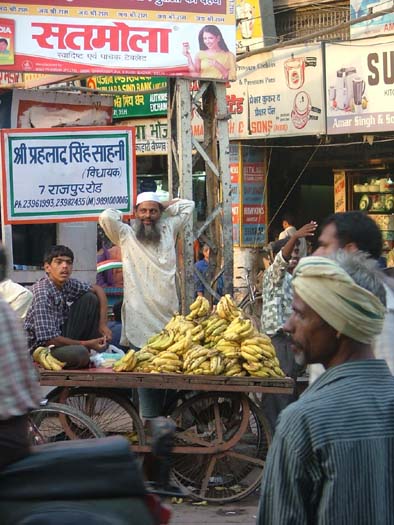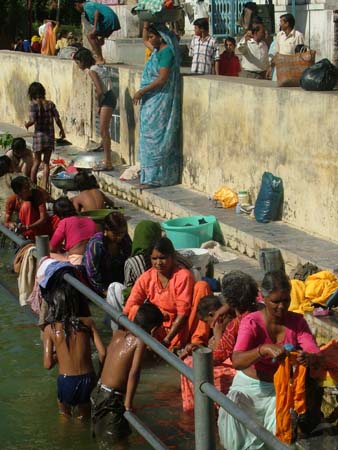DELHI — It’s mid-day on a packed street in old Delhi, I’m remarkably jet-lagged and a little shell-shocked by my new surrounds.
My partner and I arrived here from London on a whirlwind tour of India in search of the wonderful sites and sounds about which we’d heard so much.
It turns out the magnificent, semi-ordered chaos of this city of some 14 million people wouldn’t disappoint—it would, however, challenge our very exhausted mettle.
With only a short time in the Delhi, we’ve decided that the best way to immerse ourselves in local culture is on foot.
We decide that Chandni Chowk, the bustling central boulevard of Old Delhi dating back to 1648, will be our focal point.
Getting to the area from our hotel across town turns out to be an eye-opening experience all its own.
I’d been warned by friends that traffic laws are slightly different in India compared to other places.
Some might call them non-existent.
Taxis are very cheap in Delhi and are a handy and cost-efficient way to navigate the city. But it’s probably best to make sure your life insurance policy is up-to-date before buckling up.
As we drive north through Delhi, past Parliament House, the sprawling piazza known as Vijay Chowk, down streets lined with impressive embassy buildings and residences and the nearly 300-year-old Jantar Matar observatory, we cut in and out of traffic with moves that would make Michael Schumacher jealous.
Our driver slams his horn, weaves, swears at other drivers (we think) and rides his horn even more.
Road rage? No, just another day navigating these overcrowded streets. In fact, this is probably the only way to drive in Delhi and reach a destination.
With a terrified glance, my white-knuckled partner and I reach for our seatbelts only to realize this car is unequipped.
Our quiet prayers accompany the driver’s rants, probably in Hindi—we’re still not quite sure.
About five near misses with bikes, rickshaws and goats, we reach Lahore Gate, the imposing entrance to the Red Fort, Old Delhi’s most famous landmark.
The red sandstone citadel was commissioned by Mughal ruler Shah Jahan in 1639 and took nine years to construct. It now holds symbolic significance as the site where the Indian flag was first raised in 1947 after India gained independence from British rule.
With gelatin-esque legs, we step to the curb, pay the man and recommend he take up stunt driving—it pays better, after all.
The laneways around Chandni Chowk are lined with shops selling everything from spices, to gold and silver, to carpets, and every lane has its commercial specialty.
Before we can delve into this bazaar heaven, we’re approached by about 20 different men, each offering their guide services at a wide range of prices.
Still delirious with jet-lag, we accept the pitch of one driver who says, in passable English, that he knows everything about the neighborhood.
We forget to dicker over the cost, but more on that later.
As we pass through the narrow streets, monkeys fling themselves between rooftops overhead and locals stare at us as if we’re from a different planet.
This intense scrutiny takes getting used to, but we realize quickly that they’re not so much interested in us as Caucasian visitors, but rather our relative wealth.
The residents of Old Delhi tend to be extremely poor; the economic divide in the capital is glaringly obvious. The trade in the streets off of Chandni Chowk is prolific and has changed little for hundreds of years. Shopkeepers argue with buyers, not out of anger, but to secure the best possible price.
This is all part of the game. We ask our driver to stop so we can pour over one stall’s assortment of technicolor cashmere shawls. One purchase later, we move on.


Left: The markets of Old Delhi offer a wide range of food and drink. Right: Women do their weekly wash in a Delhi river.
Passing each stall means a chance to haggle with another merchant, each one vying for our Western dollars.We meet one older man selling silver who knows roughly six words in English, but armed with a calculator, communicates in keyed numbers.
I key in one price, he responds with one higher. This back-and-forth grudge match continues for five minutes before we finally settle on a reasonable price far below any I’d pay at home, but no doubt higher than market value.
Still, being a Westerner in a place where so many have so little, fighting to save what to me is less than an hour’s wage and to these people is, in some cases, a week’s or more, seems unconscionable.
A little more touring, a little more haggling and a chance to soak up a bit more of Old Delhi and our weary legs feel leaden. We thank our rickshaw driver for his services and pay the roughly $22 he charges.
Back at our hotel we ask the concierge, out of curiosity, if this toll is too much.
She says it’s actually an exorbitant amount of money, but we laugh it off without a second thought before putting our heads down for the night.
The cash is well-spent and offered a very revealing introduction to India, Delhi, and a people with whom we would soon establish a strong admiration.
Old Delhi may be chaotic, cramped and impoverished, but in just a few streets we were exposed to a passion for life and a vibrancy we’d never seen before and probably will never see again.